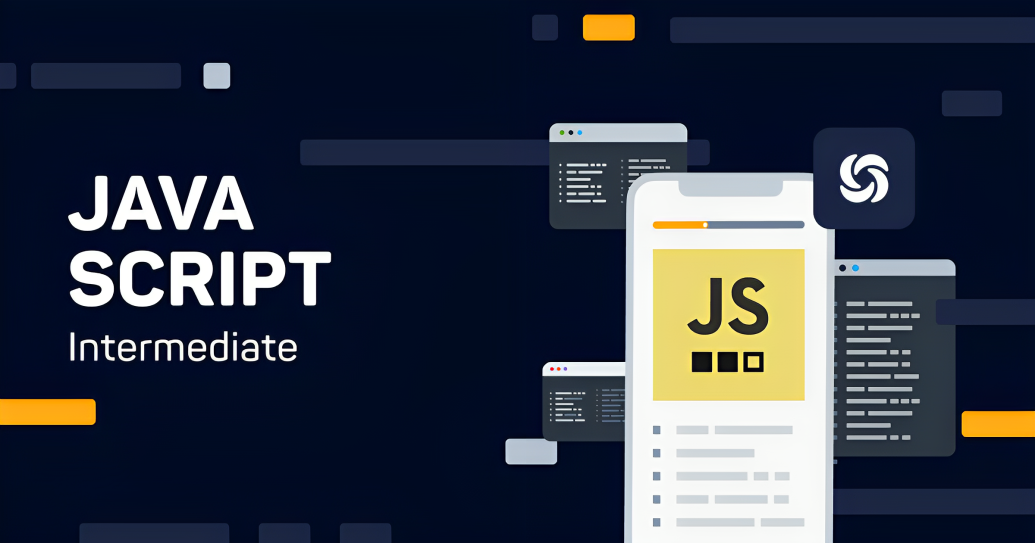JavaScript, often abbreviated as JS, is a dynamic programming language that powers the interactivity of websites and web applications. It allows developers to create everything from simple animations to complex, data-driven web applications. If you’ve already dipped your toes into the world of JavaScript, you may be ready to take your skills to the next level. This JavaScript Intermediate Course will guide you through essential concepts and techniques that will help you become a proficient JavaScript developer.
In this comprehensive guide, we’ll cover topics ranging from variables and data types to DOM manipulation, event handling, and asynchronous programming. By the end of this course, you’ll have the knowledge and skills necessary to build interactive and dynamic web applications with confidence.
Table of Contents : JavaScript Intermediate Course
- Introduction
- Getting Started
• What is JavaScript?
• Setting Up Your Environment - Variables and Data Types
• Variables
• Data Types - Control Flow
• Conditional Statements
• Loops - Functions
• Function Basics
• Scope and Closures - Working with Arrays and Objects
• Arrays
• Objects - DOM Manipulation
• Introduction to the DOM
• Modifying the DOM - Events and Event Handling
• Event Basics
• Event Handling - AJAX and Fetch
• Asynchronous JavaScript
• Making HTTP Requests - FAQ
- Conclusion
Getting Started
What is JavaScript?
Before diving into the nitty-gritty of JavaScript, let’s start with the basics. JavaScript is a high-level, interpreted programming language that was initially created to add interactivity to web pages. It is an essential component of web development alongside HTML and CSS. JavaScript allows you to create dynamic web content, handle user input, and communicate with web servers.
Setting Up Your Environment for intermediate JavaScript course
To begin your JavaScript Intermediate Course journey, you’ll need a code editor and a web browser. Popular code editors for JavaScript development include Visual Studio Code, Sublime Text, and Atom. You’ll also need a modern web browser like Google Chrome, Mozilla Firefox, or Microsoft Edge to test and run your JavaScript code.
Also Read: A Smarter way to Learn JavaScript
Variables and Data Types
Variables
In JavaScript, variables are used to store and manage data. You’ll learn how to declare and initialize variables using the var, let, and const keywords. We’ll explore variable scope, hoisting, and best practices for naming variables.
Data Types
JavaScript supports various data types, including numbers, strings, booleans, objects, arrays, and more. Understanding data types is crucial for working with data effectively and avoiding common programming errors.
Control Flow
Conditional Statements
Conditional statements allow you to make decisions in your code. We’ll cover if, else, switch, and ternary operators to control the flow of your JavaScript programs based on conditions.
Loops
Loops are used to execute a block of code repeatedly. You’ll learn about for, while, and do…while loops, along with loop control statements like break and continue.
Functions
Function Basics
Functions are reusable blocks of code that encapsulate logic. You’ll explore function declarations, expressions, parameters, and return values. We’ll also delve into anonymous functions and arrow functions.
Scope and Closures
Understanding scope is crucial for writing clean and maintainable code. We’ll discuss function scope, block scope, and closures, which enable variables to retain their values even after the function has finished executing.
Working with Arrays and Objects
Arrays
Arrays are used to store collections of data. You’ll discover how to create, manipulate, and iterate through arrays. We’ll cover common array methods like push, pop, shift, and unshift.
Objects
Objects are key-value pairs and are essential for representing complex data structures. We’ll explore object literals, methods, prototypes, and how to work with objects effectively.
DOM Manipulation
Introduction to the DOM
The Document Object Model (DOM) represents the structure of a web page in memory. You’ll learn how to access and manipulate HTML elements using JavaScript to create dynamic web applications.
Modifying the DOM
We’ll dive into DOM manipulation techniques, including selecting elements, modifying their content and attributes, and handling events triggered by user interactions.
Also Read: JavaScript DOM Manipulation Course
Events and Event Handling
Event Basics
Events are interactions or occurrences on a web page, such as clicks or keyboard inputs. You’ll gain a deep understanding of JavaScript events and how they work.
Event Handling
Event handling allows you to respond to user actions. You’ll learn how to attach event listeners to HTML elements and execute JavaScript code in response to events.
AJAX and Fetch
Asynchronous JavaScript
Asynchronous programming is a fundamental concept in modern web development. You’ll explore callbacks, promises, and the async/await syntax for managing asynchronous operations.
Making HTTP Requests
AJAX (Asynchronous JavaScript and XML) and the Fetch API enable you to send and receive data from web servers without reloading the entire page. You’ll learn how to make GET and POST requests and handle responses.
FAQ
Q1: What is the difference between var, let, and const in JavaScript?
In JavaScript, var, let, and const are used to declare variables, but they have different scopes and behaviours. var has function scope, while let and const have block scope. const variables cannot be reassigned, but let variables can.
Q2: What is a closure in JavaScript?
A closure is a function that has access to variables from its containing function, even after that function has finished executing. Closures are often used to encapsulate state and create private variables in JavaScript.
Q3: How do I handle errors in JavaScript?
You can handle errors in JavaScript using try…catch blocks. Wrap the code that might throw an error in a try block, and catch the error in the catch block, where you can handle it gracefully.
Q4: What is the purpose of the Fetch API in JavaScript?
The Fetch API is used to make HTTP requests from JavaScript. It allows you to fetch data from web servers and handle responses in a more modern and flexible way compared to older techniques like AJAX.
Conclusion
In conclusion, the JavaScript Intermediate Course has provided us with a deeper understanding of this versatile and powerful programming language. Throughout this course, we have explored a wide range of topics, from more advanced language features to practical applications in web development.
We have delved into intermediate JavaScript course topics such as functions, closures, and prototypes, gaining a solid foundation in JavaScript’s fundamental concepts. We’ve also learned how to work with asynchronous programming through promises and async/await, enabling us to create responsive and efficient web applications.
Furthermore, we’ve explored the Document Object Model (DOM) and its manipulation using JavaScript, allowing us to dynamically interact with web pages and create dynamic, interactive user interfaces. We’ve also discussed various techniques for handling events and user interactions, making our web applications more engaging and user-friendly.
Throughout the JavaScript Intermediate Course, we’ve honed our problem-solving skills by working on coding exercises and projects that challenge our ability to apply JavaScript concepts in real-world scenarios. These practical experiences have been invaluable in solidifying our understanding of JavaScript and preparing us for real-world development tasks.
As we conclude this intermediate JavaScript course, it’s important to recognize that this is just the beginning of our journey with this language. JavaScript is continually evolving, and there is always more to learn and explore. Whether you plan to pursue advanced web development, server-side scripting with Node.js, or other JavaScript-related fields, the knowledge gained in this course serves as a strong foundation for your future endeavors.
In closing, I encourage all of us to continue practicing and experimenting with JavaScript, as it is a skill that will remain in high demand in the world of technology. With dedication and persistence, we can continue to expand our expertise and create amazing web applications that push the boundaries of what is possible with this remarkable programming language.




